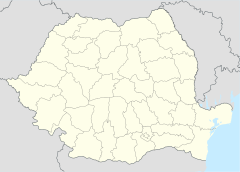
Craiova is the largest city in southwestern Romania, the seventh largest city in the country and the capital of Dolj County, situated near the east bank of the river Jiu in central Oltenia.
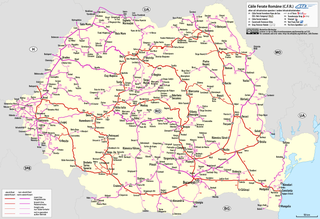
Căile Ferate Române was the state railway carrier of Romania. The company was dissolved on 1 October 1998 by splitting into several successor companies. CFR as an entity existed from 1880, even though the first railway on current Romanian territory was opened in 1854. CFR was divided into four autonomous companies:

Calafat is a city in Dolj County, southern Romania, in the region of Oltenia. It lies on the river Danube, opposite the Bulgarian city of Vidin, to which it is linked by the Calafat-Vidin Bridge, opened in 2013. After the destruction of the bridges of late antiquity, for centuries Calafat was connected with the southern bank of the Danube by boat, and later by ferryboat.
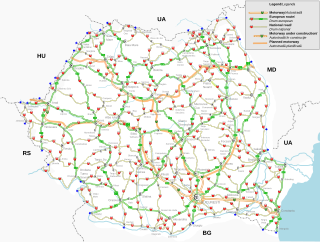
Public roads in Romania are ranked according to importance and traffic as follows:

Bucharest North railway station is the main railway station in Bucharest and the largest railway station in Romania. The vast majority of mainline trains to and from Bucharest originate from Gara de Nord.

Rail transport in Romania goes back to the Austrian Empire, when in 1857 the line between Timișoara and Szeged opened. The first railway line on territory of the Kingdom of Romania opened in 1869. It linked Bucharest and Giurgiu. Electrification of the Romanian railway network was expedited during the 1950s and 1960s while the country was under a communist regime.

The Danube Bridge is a steel truss bridge over the Danube River connecting the Bulgarian bank to the south with the Romanian bank to the north and the cities of Ruse and Giurgiu respectively. It is one of only two bridges connecting Romania and Bulgaria, the other one being the New Europe Bridge between the cities of Vidin and Calafat.

The New Europe Bridge, also known as Danube Bridge 2 is a road and rail bridge between the cities of Vidin, Bulgaria, and Calafat, Romania. It is the second bridge on the shared section of the Danube between the two countries. It is an extradosed bridge and was built by the Spanish company Fomento de Construcciones y Contratas, at the cost of €226 million. It was officially opened with a ceremony held on 14 June 2013. The first vehicles were allowed to cross the bridge after midnight, on 15 June 2013.
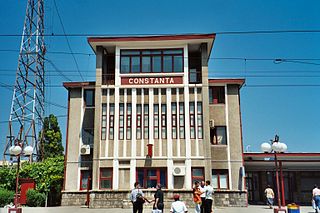
Constanţa railway station is the largest station in Constanţa and on the Romanian Black Sea coast.
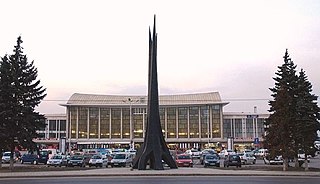
The Brașov railway station is the main station in Brașov, Romania. The building on the current location was opened to traffic in 1962. The station's bell chimes preceding the announcements represent a few notes from Ciprian Porumbescu's operetta Crai Nou.

Iași railway station is the main railway station in Iași, and one of the oldest in Romania. It is part of the Pan-European Corridor IX.

Malu Mare is a commune in Dolj County, Oltenia, Romania with a population of 7,548 people as of 2021. It is composed of two villages, Malu Mare and Preajba. It also included the village of Ghindeni until 2004, when it was split off to form a separate commune.

Poiana Mare is a commune in Dolj County, Oltenia, Romania with a population of 9,047 as of 2021. It is composed of three villages: Poiana Mare, Tunarii Noi, and Tunarii Vechi.

Piatra-Olt is a town in Olt County, Oltenia, Romania. The town administers five villages: Bistrița Nouă, Criva de Jos, Criva de Sus, Enoșești and Piatra. The town is an important railway station and road intersection. It officially became a town in 1989, as a result of the Romanian rural systematization program.
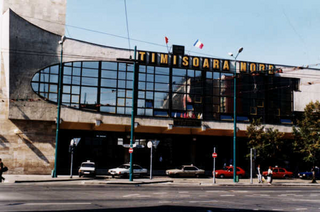
Line 900 is one of CFR's main lines in Romania having a total length of about 533 km (331 mi). The main line, connecting Bucharest with the western city of Timișoara, passes through the important cities of Craiova, Drobeta-Turnu Severin and Lugoj.
Radu Mircea Berceanu is a Romanian engineer and politician. A former member of the Democratic Liberal Party (PD-L), he was a member of the Romanian Chamber of Deputies for Dolj County from 1990 to 2004, and sat in the Romanian Senate from 2004 to 2012, representing the same county. In the Radu Vasile and Mugur Isărescu cabinets, he was Minister of Industry and Commerce from 1998 to 2000; in the first Călin Popescu-Tăriceanu cabinet, he was Minister of Transport, Construction and Tourism from 2006 to 2007; and in the Emil Boc cabinet, he was Minister of Transport and Infrastructure from December 2008 to September 2010. From October to December 2009, he was also acting Minister of Agriculture following the political crisis that led to the withdrawal of the Social Democratic Party from government.

The Corridor IV is one of the Pan-European transport corridors. It runs between Dresden/Nuremberg in Germany and Thessaloniki (Greece) / Constanța (Romania) / Istanbul (Turkey). The corridor follows the route: Dresden / Nuremberg – Prague – Vienna – Bratislava – Győr – Budapest – Arad – Bucharest – Constanța / Craiova – Sofia – Pernik - Thessaloniki or Plovdiv – Istanbul.
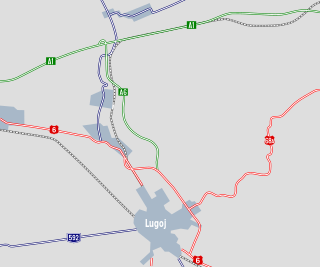
The A6 motorway is a partially built motorway in Romania, planned to connect Bucharest with the Banat region, through the southern part of the country. It will follow the route: Craiova, Calafat, Drobeta-Turnu Severin, Lugoj, connecting with the A1 motorway near Balinț. The section between Balinț and Calafat, where it will provide access to the New Europe Bridge, is part of the southern branch of the Pan-European Corridor IV.

The CFR Class TEA was a small series of electric multiple units manufactured in Romania from 1974 to 1986 for Căile Ferate Române. Due to its rarity, not much is known about this trainset, albeit a technical sheet designed for potential export does exist online.


